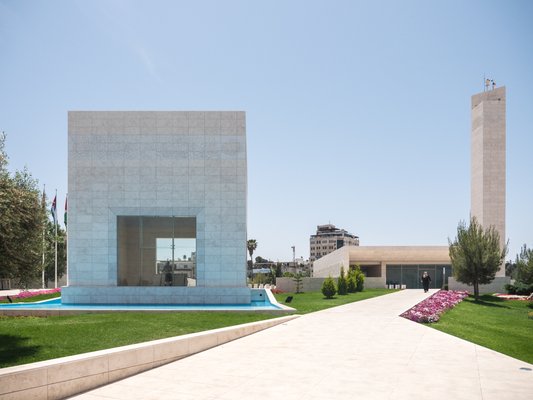The administrative center of Palestinian Authority sits among limestone hills. A modern city with active arts scene, cafes, consulates and the traditional Old City's stone houses.
Ramallah, located 16 km north of Jerusalem in the West Bank, functions as the Palestinian Territories' administrative center. The Mukataa government complex sits close to bars and cafes, and the Khalil Sakakini Cultural Center displays rotating art collections. Yasser Arafat’s marble mausoleum draws visitors less than a kilometer from Rukab’s Ice Cream, which has sold gum-resin-flavored desserts since the 1940s. Cafes serving Arabic coffee cluster around stone streets, and tech companies operate offices near shops selling embroidered textiles. Founded by Christian families in the 1500s, the city maintains churches like the Greek Orthodox Holy Family alongside Ottoman-era buildings, with summer temperatures moderated by its 872-meter elevation.
Government Centers and Cultural Hubs
Ramallah houses the Palestinian Authority’s headquarters at the Mukataa compound, a walled area containing presidential offices and Yasser Arafat’s burial site, accessible daily without an entry fee. Walk ten minutes east to reach the Mahmoud Darwish Memorial, where a museum details the poet’s life through personal manuscripts and recorded readings. The Khalil Sakakini Cultural Center occupies a 19th-century villa restored with arched windows and tiled floors, scheduling weekly film discussions and photography exhibits. Each October, the Ramallah International Film Festival screens regional documentaries at the Al-Kasaba Theatre, a venue that also produces Arabic adaptations of classic plays.
Key Locations to Explore
Begin at Al-Manara Square, a circular plaza where locals gather at coffee stands under pine trees. Narrow streets radiate from here into the Old City market, with stalls selling za’atar spices, hand-stitched pillow covers, and carved olive wood boxes. The Ramallah Cultural Palace, a glass-and-concrete structure funded by international donors, holds piano recitals and student theater performances. Hiking paths start at the city’s eastern edge, leading to villages such as Jifna, where Roman water channels cut through apricot groves. The Friends School campus, established by Quaker missionaries, preserves original 19th-century classrooms and a library with century-old textbooks.
Local Eats and Evening Spots
Street vendors near Al-Manara serve falafel in pita bread for 5 shekels, topped with pickled turnips and tahini. Rukab’s Ice Cream remains a staple, with its mastic-flavored scoops retaining a chewy texture unique to the region. For sit-down meals, try Fuego’s shawarma tacos or Orjuwan Lounge’s platters of hummus, stuffed grape leaves, and grilled halloumi. After sunset, bars like La Grotta open their terraces, serving Palestinian craft beers and hosting jazz bands on weekends. Most establishments serve alcohol, reflecting the city’s Christian minority influence, though moderation is typical.
Nearby Excursions
Birzeit University, a 15-minute drive north, offers guided walks through its archaeological museum displaying Bronze Age tools and Byzantine coins. In Jifna, a village accessible by shared taxi, inspect the floor mosaics of a 5th-century church partially reconstructed in the 1800s. The Tall al-Naṣbah archaeological site reveals stone walls from an Iron Age settlement, with free admission and interpretive signs in English. Join a half-day tour to Deir Ghassaneh to observe traditional olive oil production or visit Taybeh’s brewery, which offers tastings of amber ale made with local barley.
Travel Logistics
Buses from Jerusalem’s Damascus Gate depart every 20 minutes for Ramallah, taking 30 minutes via the Qalandia checkpoint. Taxis within the city charge fixed rates, but central areas like Al-Manara and the Old City are walkable. Stay at the Eco Hostel for dorm beds or book a room at the Grand Park Hotel for mountain views. Avoid photographing military checkpoints and monitor local news for updates on political tensions. Most shopkeepers and taxi drivers understand basic English, and ATMs dispense Israeli shekels.
Historical Development
Christian families from Karak in Jordan established Ramallah in the mid-16th century, building stone houses with red-tiled roofs still visible in the Old City. During the British Mandate, wealthy Jerusalem families constructed summer homes here, including the Sakakini villa with its ornate wood ceilings. After 1948, refugees from coastal cities increased the Muslim population, though churches like the Lutheran Christmas Church continued operating. Recent urban projects focus on expanding green spaces and supporting software startups to strengthen the local economy.
Arts and Learning Institutions
Birzeit University’s museum curates Neolithic pottery and Ottoman land deeds, open to visitors on weekdays. The Popular Art Center teaches Palestinian embroidery patterns and dabke folk dancing through weekend workshops. Zawyeh Gallery in downtown Ramallah rotates exhibitions of paintings by artists from Gaza and the West Bank, with pieces available for purchase. The city’s main library archives Ottoman tax records and hosts monthly lectures on Palestinian literature. Every April, the “Saturday of Light” festival sees scouts march through streets carrying lanterns lit in Jerusalem’s Old City.













